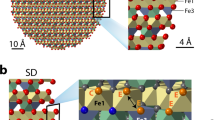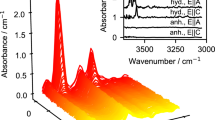Abstract
Techniques of X-ray photoelectron and Auger electron spectroscopy, scanning probe microscopy were used to demonstrate that the natural surface of hydrothermally synthesized pyrite, as well as vacuum fractures, contain a number of sulfide-sulfur species: disulfide, monosulfide, and, more rarely, polysulfide. The natural surface of hydrothermal pyrite is chemically modified compared to the inner volume into a nonautonomous phase film up to ∼500 nm thick, which has a variable composition resembling that of pyrrhotite but with broader variations toward FeS2. Its principal distinctive feature is the presence of a peak at ∼710 eV in the XPS Fe 2p3/2 spectrum, which is often higher than the main peak of bivalent low-spin Fe(II) in the pyrite structure (707 eV). The “basic” structure of the nonautonomous phase is a layer of variable composition Fe2+[S, S2, S n ]2−, whose S/S2 ratio varies from ∼0.5 to ∼2.0, averaging at ∼1.1. This layer may include admixtures of minor elements, as follows from the appearance of a nonautonomous phase in the presence of As, which does not, however, form an individual phase. The polymerization of S at the surface is thereby more significant. The major oxisulfide components of this phase may be the sulfite and thiosulfate ions at a subordinate concentration of sulfate because of the instability of coexisting sulfate and disulfide ions, which results, in the presence of oxygen, in sulfite (thiosulfate) and sulfide ions in the nonautonomous phase. In line with XPS, scanning probe microscopic (SPM) data show that, at a high S activity in the “pure” system, the surface of the crystals contains practically no nanometer-sized phases and is characterized by low roughness (14–17 nm). At a low S fugacity in equilibrium with pyrrhotite and sphalerite, the average roughness of the surface increases to 25–65 nm, with the maximum height of the surface features of ∼100–500 nm. This is consistent with Auger spectroscopic data, obtained after the etching (ion milling) of the surface with Ar+, on the thickness of the nonstoichiometric surface layer. Comparison with analogous data on other sulfides shows that crystals growing in hydrothermal environments have surface layers up to ∼500 nm thick, which are different from the main volume of the crystal in chemistry, stoichiometry, and, possibly, also structure. This is scale of the surface heterogeneity at which the typochemistry of mineral surfaces may be manifested. The typochemistry of pyrite stems from the ability of the nonautonomous phase to “record” the growth conditions of crystals in terms of two major factors: the purity of the system (the occurrence of other phases, including virtual ones, i.e., potentially possible phases of admixture elements) and S fugacity (which influences the S/S2 ratio at the surface). The geochemical role of the surface nonautonomous phase in pyrite may be very significant, particularly when minor elements are captured that are incompatible with the pyrite structure but can be easily accommodated in the less rigid structure of the nonautonomous phase.
Similar content being viewed by others
References
H. W. Nesbitt, M. Scaini, H. Hochst, et al., “Synchrotron XPS Evidence for Fe2+-S and Fe3+-S Surface Species on Pyrite Fracture-Surface, and Their 3D Electronic States,” Am. Mineral. 85, 850–857 (2000).
S. L. Harmer and H. W. Nesbitt, “Stabilization of Pyrite (FeS2), Marcasite (FeS2), Arsenopyrite (FeAsS) and Loellingite (FeAs2) Surfaces by Polymerization and Auto-Redox Reactions,” Surf. Sci. 564, 38–52 (2004).
V. L. Tauson, R. G. Kravtsova, and V. I. Grebenshchikova, “Chemical Typomorphism of the Surface of Pyrite Crystals of Gold Ore Deposits,” Dokl. Akad. Nauk 399(5), 673–677 (2004) [Dokl. Earth Sci. 399A, 1291–1295 (2004)].
V. L. Tauson and R. G. Kravtsova, “Typochemistry of Mineral Surface: Features of Surface Composition (Evidence from Gold-Bearing Pyrite from an Epithermal Deposit),” Geol. Geofiz. 45(2), 222–227 (2004).
S. D. Sher and A. V. Demchenko, “On the Significance of Studying the Morphology of Pyrite Metacrysts in Searching for Gold Deposits in the Lena Region,” Geol. Rudn. Mestorozhd., No. 4, 84–96 (1962).
T. T. Lyakhovich and I. V. Vedyaeva, “Typochemistry of Pyrites—Criteria for Searching for and Identification of Ore Deposits,” Razved. Okhr. Nedr, No. 8, 31–34 (2002).
V. L. Tauson, I. Yu. Parkhomenko, D. N. Babkin, et al., “Cadmium and Mercury Uptake by Galena Crystals under Hydrothermal Growth: A Spectroscopic and Element Thermo-Release Atomic Absorption Study,” Eur. J. Mineral. 17, 599–610 (2005).
V. L. Tauson and V. V. Akimov, “Effect of Crystallite Size on Solid State Miscibility: Applications to the Pyrite-Cattierite System,” Geochim. Cosmochim. Acta 55(10), 2851–2859 (1991).
V. L. Tauson and R. G. Kravtsova, “Estimates of Gold Admixture in the Structure of Pyrite from Epithermal Gold-Silver Deposits, Northeastern Russia,” Zap. Vseross. Mineral. O-va 131(4). 1–11 (2002).
Practical Surface Analysis: Auger and X-Ray Photoelectron Spectroscopy, Ed. by D. Briggs and M. P. Seah (Wiley, Chichester, 1990; Mir, Moscow, 1987) [in Russian].
A. G. Schaufuss, H. W. Nesbitt, I. Kartio, et al., “Reactivity of Surface Chemical States on Fractured Pyrite,” Surf. Sci. 411, 321–328 (1998).
M. Descostes, F. Mercier, N. Thromat, et al., “Use of XPS in the Determination of Chemical Environment and Oxidation State of Iron and Sulfur Samples: Constitution of a Data Basis in Binding Energies for Fe and S Reference Compounds and Applications to the Evidence of Surface Species of an Oxidized Pyrite in a Carbonate Medium,” Appl. Surf. Sci. 165, 288–302 (2000).
J. R. Mycroft, G. M. Bancroft, N. S. McIntyre, et al., “Detection of Sulphur and Polysulphides on Electrochemically Oxidized Pyrite Surfaces by X-Ray Photoelectron Spectroscopy and Raman Spectroscopy,” J. Electroanal. Chem. 292, 139–152 (1990).
A. M. Widler and T. M. Seward, “The Adsorption of Gold (I) Hydrosulphide Complexes by Iron Sulfide Surfaces,” Geochim. Cosmochim. Acta 66(3), 383–402 (2002).
A. R. Pratt, I. J. Muir, and H. W. Nesbitt, “X-Ray Photoelectron and Auger Electron Spectroscopic Studies of Pyrrhotite and Mechanism of Air Oxidation,” Geochim. Cosmochim. Acta 58(2), 827–841 (1994).
J. E. Thomas, W. M. Skinner, and R. St. C. Smart, “A Comparison of the Dissolution Behavior of Troilite with Other Iron (II) Sulfides: Implications of Structure,” Geochim. Cosmochim. Acta 67(5), 831–843 (2003).
J. E. Maulder, W. F. Stickle, P. E. Sobol, and K. D. Bomben, “Handbook of X-Ray Spectroscopy. (A Reference Book of Standard Spectra for Identification and Interpretation of XPS Data),” (Perkin-Elmer Corp., Norwalk, 1990).
C. D. Wagner, A. V. Naumkin, A. Kraut-Vass, et al., NIST X-ray Photoelectron Database www.nist.gov/srd/online.htm .
A. G. Schaufuss, H. W. Nesbitt, I. Kartio, et al., “Incipient Oxidation of Fractured Pyrite Surfaces in Air,” J. Electron. Spec. Relat. Phenom 96, 69–82 (1998).
C. M. Eggleston, J.-J. Ehrhardt, and W. Stumm, “Surface Structural Controls on Pyrite Oxidation Kinetics: An XPS-UPS, STM, and Modeling Study,” Am. Mineral. 81, 1036–1056 (1996).
V. L. Tauson and N. V. Smagunov, “Composition of the Surface of Pyrrhotite (Fe1-xS) Crystals Synthesized in Association with Greenockite (α-(Cd,Fe)S) under Hydrothermal Conditions: Introduction into the Geochemistry of Nonautonomous Phases,” Geokhimiya, No. 4, 448–454 (2004) [Geochem. Int. 42, 377–382 (2004)].
Yu. L. Mikhlin, A. V. Kuklinskiy, N. I. Pavlenko, et al., “Spectroscopic and XRD Studies of the Air Degradation of Acid-Reacted Pyrrhotites,” Geochim. Cosmochim. Acta 66(23), 4057–4067 (2002).
Yu. L. Mikhlin, Ye. V. Tomashevich, G. L. Pashkov, et al., “Electronic Structure of Non-Equilibrium Iron-Deficient Layer at Hexagonal Pyrrhotite,” Appl. Surf. Sci. 125, 73–84 (1998).
A. S. Manocha and R. L. Park, “Flotation Related ESCA Studies on PbS Surfaces,” Appl. Surf. Sci. 1, 129–141 (1977).
H. W. Nesbitt and I. J. Muir, “X-Ray Photoelectron Spectroscopic Study of a Pristine Pyrite Surface Reacted with Water Vapour and Air,” Geochim. Cosmochim. Acta 58(21), 4667–4679 (1994).
K. Sasaki, “Effect of Grinding on the Rate of Oxidation of Pyrite Oxygen in Acid Solutions,” Geochim. Cosmochim. Acta 58(21), 4649–4655 (1994).
H. W. Nesbitt, G. M. Bancroft, A. R. Pratt, and M. J. Scaini, “Sulfur and Iron Surface States on Fractured Pyrite Surface,” Am. Mineral. 83, 1067–1076 (1998).
S. Karthe, R. Szargan, and E. Suoninen, “Oxidation of Pyrite Surfaces: A Photoelectron Spectroscopic Study,” Appl. Surf. Sci. 72, 157–170 (1993).
V. L. Tauson, “Systematics of Processes of Trace Element Uptake by Real Mineral Crystals,” Geokhimiya, No. 2, 213–219 (2005) [Geochem. Int. 43, 184–190 (2005)].
V. L. Tauson, B. A. Loginov, V. V. Akimov, and S. V. Lipko, “Nonautonomous Phases as Potential Sources of Incompatible Elements,” Dokl. Akad. Nauk 406(6), 806–809 (2006) [Dokl. Earth Sci. 407, 280–283 (2006)].
B. C. Bostick, S. Fendorf, and M. Fendorf, “Disulfide Disproportionation and CdS Formation upon Cadmium Sorption on FeS2,” Geochim. Cosmochim. Acta 64, 247–255 (2000).
V. L. Tauson and A. N. Sapozhnikov, “Stability of the Modulated Structure of Baikal Lazurite and Its Recrystallization at a Temperature of 600°C over a Wide Range of Sulfur Dioxide Fugacities,” Crystallogr. Rept. 50(Suppl. 1), 1–9 (2005).
Author information
Authors and Affiliations
Corresponding author
Additional information
Original Russian Text © V.L. Tauson, D.N. Babkin, E.E. Lustenberg, S.V. Lipko, I.Yu. Parkhomenko, 2008, published in Geokhimiya, 2008, No. 6, pp. 615–628.
Rights and permissions
About this article
Cite this article
Tauson, V.L., Babkin, D.N., Lustenberg, E.E. et al. Surface typochemistry of hydrothermal pyrite: Electron spectroscopic and scanning probe microscopic data. I. Synthetic pyrite. Geochem. Int. 46, 565–577 (2008). https://doi.org/10.1134/S0016702908060037
Received:
Published:
Issue Date:
DOI: https://doi.org/10.1134/S0016702908060037




